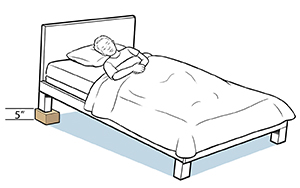A
B
C
D
E
F
G
H
I
J
K
L
M
N
O
P
Q
R
S
T
U
V
W
X
Y
Z
Click a letter to see a list of conditions beginning with that letter.
Click 'Topic Index' to return to the index for the current topic.
Click 'Library Index' to return to the listing of all topics.
GERD (Gastroesophageal Reflux Disease) in Children
GERD stands for gastroesophageal reflux disease. You may also hear it called acid indigestion or heartburn. It happens when stomach contents flow back up (reflux) into the tube that connects the mouth to the stomach. This tube is called the esophagus. GERD can irritate the esophagus. It can cause problems with swallowing or breathing. In severe cases, GERD can cause serious problems, such as pneumonia that keeps coming back. So it’s best for any child with GERD to be seen by a healthcare provider.
Symptoms of GERD in children
GERD can cause symptoms such as:
-
A burning feeling in the chest, neck, or throat (heartburn)
-
Feeling of food or liquid coming up in the back of the mouth
-
Gagging, choking, or trouble swallowing
-
Frequent wheezing episodes
-
A cough that doesn’t go away (persistent cough), especially at night or when you wake up
-
Hoarse or raspy voice
-
Bad breath
-
Sore throat in the morning
Diagnosing GERD
Your child's healthcare provider may diagnose GERD based on your child's symptoms. In some cases, testing may be advised to find what is causing your child’s symptoms. Common tests for diagnosing GERD include:
-
Upper GI series, also called a barium swallow. Barium is a thick, chalky liquid. When swallowed, it makes the esophagus and stomach show up on X-rays.
-
Endoscopy. Your child is given a medicine (anesthesia) to make him or her fall asleep. Then a tube (endoscope) with a light and a tiny video camera on it is put down your child’s throat. This lets the provider look at your child’s esophagus and stomach.
-
A 24-hour esophageal pH study. The provider puts a very thin tube into your child’s esophagus. This tube is connected to a monitor that records acid levels and reflux activity for a day or longer.
Treating GERD in children
Treatment depends on your child’s age, and how severe the symptoms are. Sometimes symptoms can cause poor weight gain. In many cases, making the changes listed below will be enough to ease symptoms. In some cases, medicines may be prescribed to help reduce stomach acid. Rarely, surgery may be advised for severe symptoms that don’t respond to treatment.
Helping your child feel better
 |
| Raise the head of the child’s bed using sturdy blocks or books. (This should not be done for infants.) |
To help prevent or reduce GERD symptoms:
-
Have your child eat smaller but more frequent meals.
-
Make sure your child stops eating at least 3 hours before going to bed.
-
Don't let your child lie down or recline for 2 hours after meals.
-
Stay away from food and drink that can make GERD worse. These include:
-
Chocolate, peppermint, fizzy drinks, and drinks that have caffeine
-
Acidic foods (such as vinegar, citrus fruits and juices, and tomato products)
-
High-fat foods (such as French fries, fast food, and pizza)
-
Spicy foods
-
Fried foods
-
Raise the head of your child’s bed 5 inches. This can help prevent reflux at night.
-
Make sure your child’s clothing is loose and comfortable, especially around the waist.
-
Help your child lose weight if they are overweight.
-
Keep tobacco smoke away from your child.
Online Medical Reviewer:
Liora C Adler MD
Online Medical Reviewer:
Raymond Kent Turley BSN MSN RN
Online Medical Reviewer:
Rita Sather RN
Date Last Reviewed:
2/1/2022
© 2000-2025 The StayWell Company, LLC. All rights reserved. This information is not intended as a substitute for professional medical care. Always follow your healthcare professional's instructions.